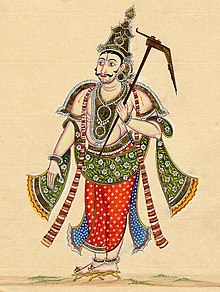Dauwa Ahir
Dauwa Ahir or Dauwa Yadav are a Gotra (Clan) of Ahirs found in the Bundelkhand region[1] which was the ancient Cedi Kingdom. They are also known as Dau, Dauwa, Doa or Daua.[2][3] They are also addressed as Dau Sahab or Thakur Sahab due to their power and influence in Bundelkhand.[4]

Origin
They claim descent from Lord Balarama (brother of Shree Krishna) and Alha & Udal; the 12th century Ahir generals[5] of Parmal.[1]
History
They ruled a estate in the Bundelkhand Agency i.e., the Naigaon-Rebai State during British India.[6] In Mediaeval era, they served as important generals and commanders in the army of the ruling clans such as, the Chandelas or the Bundelas.[7][8] They actively participated in wars along with them.[9][10][8] In Prithviraj-Raso, a Dau warrior named Dongar Singh Dauwa is mentioned who is fighting along with Udal.[8]
Battle of Bhurgarh
At Banda there was dispute between Nawab of banda and Ranjor Dauwa (Ahir) of Ajaygarh. A battle had beed fought between them for the possession of the Bhurgarh fort (near banda) in which Ranjor dauwa and his Men became Victorious.[11][12]
Notable People
- Raiman Singh Dauwa, a warrior of Bundelkhand
- Thakur Ratan Singh, Jagirdar of Naigawan-Rebai[13]
- Bodhan Daua, An Indian revolutionary[14][15]
- Lalsinh Dauwa, Commander of Vijayraghavgarh[16]
References
- ^ a b Singh, Mahendra Pratap (2001). Shivaji, Bhakha Sources and Nationalism. Books India International.
- ^ Hindī bhāshā kī śabda-saṃracanā (in Hindi). Sāhitya Sahakāra. 1985.
- ^ Jain, Ravindra K. (2002). Between History and Legend: Status and Power in Bundelkhand. Orient Blackswan. ISBN 978-81-250-2194-0.
- ^ Siddiqui, A. U. (2004). Indian Freedom Movement in Princely States of Vindhya Pradesh. Northern Book Centre. ISBN 978-81-7211-150-2.
- ^ Garrick, H. B. W.; Cunningham, Sir Alexander (1885). Report of a Tour Through Behar, Central India, Peshawar, and Yusufzai, 1881-82. Office of the Superintendent of Government Printing.
- ^ The Imperial Gazetteer of India: Moram to Nayāgarh. Today & Tomorrow's Printers & Publishers. 1972.
- ^ Divedi, Syam Sundar (1956). Veersingh Dev Charit.
- ^ a b c Chandbardai (1913). Prithviraj Raso Vol. - Vi.
- ^ Gupta, Asha (1999). Aalha Khand (in Hindi). Vāṇī Prakāśana.
- ^ Parishada, Madhyapradeśa Ādivāsī Lokakalā (2001). Candelakālīna lokamahākāvya Ālhā: prāmāṇika pāṭha (in Hindi). Madhyapradeśa ĀDivisionāsī Lokakalā Parishad.
- ^ Journal of Historical Research. Department of History, Ranchi University. 1959.
- ^ Oudh (India), United Provinces of Agra and (1929). District Gazetteers of the United Provinces of Agra and Oudh: Banda. Supdt., Government Press, United Provinces.
- ^ Memoranda on the Indian States. Manager of Publications. 1939.
- ^ Miśra, Sureśa (2004). 1857, Madhyapradeśa ke raṇabān̐kure (in Hindi). Svarāja Saṃsthāna Sañcalanālaya, Saṃskr̥ti Vibhāga, Madhyapradeśa Śāsana.
- ^ Devi, Mahashweta (2003-01-01). Jhansi Ki Rani (in Hindi). Rajkamal Prakashan. ISBN 978-81-7119-853-5.
- ^ Miśra, Sureśa (2004). 1857, Madhyapradeśa ke raṇabān̐kure (in Hindi). Svarāja Saṃsthāna Sañcalanālaya, Saṃskr̥ti Vibhāga, Madhyapradeśa Śāsana.